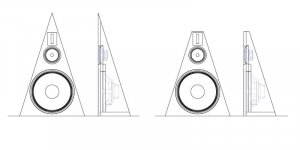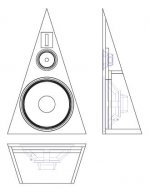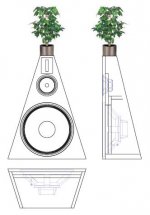studiotech said:
Yes sir.
Greg
How much is the retail price for TPL-150?
You mean with the terminals on the top? Yes, I noticed that. However, with a tight enough baffle cutout it wont come out ayway.studiotech said:StigErik, are you running the TPL upside down to keep the diaphragm in place with no chance of it sliding out. That's the only issue for me with leaving the back cover off. It has that little lip to hold it in there.
Greg
jeroen_d said:Very nice project! Only problem I would have is the mid and tweeter being positioned rather low, I suspect that the centre of the mid is at about 27"?
Currently, the mid and tweeter is centered 75 cm (30") and 99 cm (39") above the floor. We will put the tweeter and the midrange closer together, and lower the tweeter slightly to 95 cm to get it down to ear-height (to my ears at least).
I am also thinking of building a second prototype with a more refined shape. This pineboad version we have now sure sound better than it looks.... a combination of nice looks and great sound wont hurt!
ttan98 said:
How much is the retail price for TPL-150?
I'll have to check with the bossman. Been almost a year since we ordered them.
Greg
Ok people, we want some help with the looks of this thing! The main problem is that the 21" woofer is big... very big. The speaker need to be wide, as the bottom at least.
We have made a simple drawing of two possible solutions. Its important for us to keep the design relatively simple to manufacture, thats why there are no fancy shapes.
Please let me know what you think, and any suggestions are welcome!
We have made a simple drawing of two possible solutions. Its important for us to keep the design relatively simple to manufacture, thats why there are no fancy shapes.
Please let me know what you think, and any suggestions are welcome!
Attachments
Hi StigErik,
I think the design looks great!
I have another suggestion, though: I understand that you like to Seas W22 a lot, but it has by far the lowest sensitivity of the drivers chosen. Have you thought about a more efficient mid-driver or maybe to use two drivers? Just a thought...
Best regards
Peter
I think the design looks great!
I have another suggestion, though: I understand that you like to Seas W22 a lot, but it has by far the lowest sensitivity of the drivers chosen. Have you thought about a more efficient mid-driver or maybe to use two drivers? Just a thought...
Best regards
Peter
Awsome Beyma set up
Hi StigErik,
I will send you (and Telstar) a few photos which are too big file size to post (and way to ugly anyway!) they might be of interest.
The test cabinets housed a 15 inch Beyma SM 115 K bass driver, an 8 inch Seas Excel W22EX001 for lower mids, and a Manger driver above 400Hz.
I like your trapezoid (with plant pot option...!) but I can see how the "full pointy hat" triangle will have some sonic benefit. It would be very interesting to compare the two baffle shapes if you can be bothered to build two pairs and do all the driver swaps and measurements... please!
I definitely recommend asymmetry wherever possible. Symmetry is the beautiful enemy!
Any open baffle system I have experimented with always benefits sonically from asymmetry.
The "Variable Path Length" (VPL) cancellation really helps a lot between 100Hz and 400Hz. It reduces the peaks due to the U frame or H frame dimensional step.
Your angular sides will have a similar effect, the VPL just allows you to have deeper sides therefore more low frequency or low mid range reinforcement without the penalty of the "cuppy" lower mids and boomy bass you get from straight sided deep U or H sides.
On the Beyma 21 SW11600Nd, it's an astonishing feat of engineering, BUT... I have a feeling that the Mms to Bl ratio is too high for open baffle. Mms is 370g (WOW!) and the Bl is 32 (still wow!) but the ratio is a huge 11.5. I have never been able to achieve fast bass with any size of driver (multiple 12,s or 15,s or single 18 inch) with a Mms divided by Bl figure of 7 or more.
Really fast bass drivers are all in the 3.5 to 5.5 bracket.
I have always found it's not how fast it accelerates, it's how fast it can stop, that defines the speed (therefore the quality) of the bass. I have posted more on this on the Manger thread in the Full range section.
Also the Thermal compression chart looks a bit scary compared to some of the Precision Devices i.e. the 18 inch PD 1850 has 1.6dB thermal compression at 800 watts continuous Vs the Beyma 21 incher having 3dB at 800 watts. Would a pair of 18 inchers be a possible option? Same power handling, greater efficiency, half the Thermal compression, similar cost, but big!!
Anyway which ever route you go this is going to end up being one totally awesome speaker system, and as a showcase for Beyma technology Beyma should pay you or at least give you a free pair of those 21 inchers!
I really would love to hear this system one day!
By the way was it my two way "Encore" or my 3 way "Finale" speakers you heard in Bergen? Ole Martins Finale are great now he has tri-amped them with 3 big Dynamic Precision power amps!
All the best
Derek.
Hi StigErik,
I will send you (and Telstar) a few photos which are too big file size to post (and way to ugly anyway!) they might be of interest.
The test cabinets housed a 15 inch Beyma SM 115 K bass driver, an 8 inch Seas Excel W22EX001 for lower mids, and a Manger driver above 400Hz.
I like your trapezoid (with plant pot option...!) but I can see how the "full pointy hat" triangle will have some sonic benefit. It would be very interesting to compare the two baffle shapes if you can be bothered to build two pairs and do all the driver swaps and measurements... please!
I definitely recommend asymmetry wherever possible. Symmetry is the beautiful enemy!
Any open baffle system I have experimented with always benefits sonically from asymmetry.
The "Variable Path Length" (VPL) cancellation really helps a lot between 100Hz and 400Hz. It reduces the peaks due to the U frame or H frame dimensional step.
Your angular sides will have a similar effect, the VPL just allows you to have deeper sides therefore more low frequency or low mid range reinforcement without the penalty of the "cuppy" lower mids and boomy bass you get from straight sided deep U or H sides.
On the Beyma 21 SW11600Nd, it's an astonishing feat of engineering, BUT... I have a feeling that the Mms to Bl ratio is too high for open baffle. Mms is 370g (WOW!) and the Bl is 32 (still wow!) but the ratio is a huge 11.5. I have never been able to achieve fast bass with any size of driver (multiple 12,s or 15,s or single 18 inch) with a Mms divided by Bl figure of 7 or more.
Really fast bass drivers are all in the 3.5 to 5.5 bracket.
I have always found it's not how fast it accelerates, it's how fast it can stop, that defines the speed (therefore the quality) of the bass. I have posted more on this on the Manger thread in the Full range section.
Also the Thermal compression chart looks a bit scary compared to some of the Precision Devices i.e. the 18 inch PD 1850 has 1.6dB thermal compression at 800 watts continuous Vs the Beyma 21 incher having 3dB at 800 watts. Would a pair of 18 inchers be a possible option? Same power handling, greater efficiency, half the Thermal compression, similar cost, but big!!
Anyway which ever route you go this is going to end up being one totally awesome speaker system, and as a showcase for Beyma technology Beyma should pay you or at least give you a free pair of those 21 inchers!
I really would love to hear this system one day!
By the way was it my two way "Encore" or my 3 way "Finale" speakers you heard in Bergen? Ole Martins Finale are great now he has tri-amped them with 3 big Dynamic Precision power amps!
All the best
Derek.
Thanks a lot!pk said:Hi StigErik,
I think the design looks great!
I have another suggestion, though: I understand that you like to Seas W22 a lot, but it has by far the lowest sensitivity of the drivers chosen. Have you thought about a more efficient mid-driver or maybe to use two drivers? Just a thought...
Best regards
Peter
I dont worry about the different sensitivities. The tweeter is attenuated 11 dB in the current X-over. The W22 is somewhere just below 90 dB in the open baffle, which is very good! The woofer is however a lot less sensitive than the mid below 50 Hz....
I selected the Seas W22 for its great sound and low distortion.
Derek,
We have considered triple 12" and dual 18" drivers, but it would require that one bass driver be placed above the mid and tweeter, creating new problems... and the speaker would become very tall. Thats why we want a single, large diameter bass driver, and the 21" Beyma is our best option (partly because I'm a Beyma dealer).
Since this is my first OB design, I have no experience on what type of driver that actually sounds best. The Beyma 18G50 we use now sure sounds fast! When is comes to bass-reflex and closed box woofers, my findings are that the "fastest" drivers are the ones with the highest Qms. About the "stopping power": wouldn't the Qes tell it all? Lower Qes should be equal to greater "braking"?
I read from the preliminary data sheet on the 21SW1600 that Mms is 370 grams. That seems a bit odd, since the older 21L50 is "just" 287 grams, and the two have comparable sensitivity without much difference in BL. I'll check this out. 370 grams seems very high.
PS. It was the Encore I heard in Bergen last year. I'm hoping to get a chance to hear the Finale as well this spring. 3-way digital XO, great drivers, great amps.. what more could you ask for?
We have considered triple 12" and dual 18" drivers, but it would require that one bass driver be placed above the mid and tweeter, creating new problems... and the speaker would become very tall. Thats why we want a single, large diameter bass driver, and the 21" Beyma is our best option (partly because I'm a Beyma dealer).
Since this is my first OB design, I have no experience on what type of driver that actually sounds best. The Beyma 18G50 we use now sure sounds fast! When is comes to bass-reflex and closed box woofers, my findings are that the "fastest" drivers are the ones with the highest Qms. About the "stopping power": wouldn't the Qes tell it all? Lower Qes should be equal to greater "braking"?
I read from the preliminary data sheet on the 21SW1600 that Mms is 370 grams. That seems a bit odd, since the older 21L50 is "just" 287 grams, and the two have comparable sensitivity without much difference in BL. I'll check this out. 370 grams seems very high.
PS. It was the Encore I heard in Bergen last year. I'm hoping to get a chance to hear the Finale as well this spring. 3-way digital XO, great drivers, great amps.. what more could you ask for?
Re: Awsome Beyma set up
This version was considered on an early stage....Overkill Audio said:Hi StigErik,
I like your trapezoid (with plant pot option...!)
Attachments
StigErik said:What about this design?
I f you do kind of U frame bass you might have to cross too low for your mid.
Check out John Kreskovsky's page as he has done throughout research and description of this principle and is very helpfull around here as well.
I have my double 15" crossed at 300Hz which is no problem for OB - both for the bass (quick enough to keep up) and the mid (not too low to increase IM too much)
Michael
Funny that both Dan Wiggins and Nick McKinney, who know a little about driver design, consider BL/Mms to be irrelevant.
Bl/mms = nonsense
Woofer Speed .pdf
Bl/mms = nonsense
Woofer Speed .pdf
Re: Awsome Beyma set up
Yes, also my experience - even and especially for the AMT !
A few weeks ago I have changed to a diamond kind of shape for the AMT and to me it was a clear progress - the speakers are less easy to localisate (from their heigths)
You can do simus with rectangular diaphragm shapes in Edge that also indicate better behaviour with OB boundarys not in parallel to the rectangular diaphragm
Hence my vote for the "magicians hat" was not (only) out of fun - would be interested if it turns out for you the same
Michael
Overkill Audio said:
...but I can see how the "full pointy hat" triangle will have some sonic benefit.
Yes, also my experience - even and especially for the AMT !
A few weeks ago I have changed to a diamond kind of shape for the AMT and to me it was a clear progress - the speakers are less easy to localisate (from their heigths)
You can do simus with rectangular diaphragm shapes in Edge that also indicate better behaviour with OB boundarys not in parallel to the rectangular diaphragm
Hence my vote for the "magicians hat" was not (only) out of fun - would be interested if it turns out for you the same
Michael
StigErik,
there are two different (or almost contrary) roads you can go in dipole design. The easy road is wide baffles and/or wings, which keeps efficiency up and the power demand on drivers low. What you sacrifice that way (not only due to the need to place drivers off axis on wide baffles) is a constant and symmetric dipole radiation pattern.
The alternative road is along the findings of people like Linkwitz and Kreskovsky, who try to keep every drivers working range below (or at least not much higher than) the first dipole peak of the baffle area where the driver is mounted.
Your triangular baffle would be perfect for the second approach, but wings must be limited to the woofer area. Midrange driver and tweeter should see a plain baffle only. John Kreskovsy has given some information in his Dipoles and Open Baffle Design considerations. By following his (and SLs) rules you can achieve an almost constant horizontal directivity pattern from bass up to the TPL 150. The price you have to pay is the need to equalize the 6 db/oct dipole loss and the adjacent dipole peak for every driver on the baffle.
It would help if you could explain the design goals and limitations behind your dipole project WRT these alternative roads.
Rudolf
there are two different (or almost contrary) roads you can go in dipole design. The easy road is wide baffles and/or wings, which keeps efficiency up and the power demand on drivers low. What you sacrifice that way (not only due to the need to place drivers off axis on wide baffles) is a constant and symmetric dipole radiation pattern.
The alternative road is along the findings of people like Linkwitz and Kreskovsky, who try to keep every drivers working range below (or at least not much higher than) the first dipole peak of the baffle area where the driver is mounted.
Your triangular baffle would be perfect for the second approach, but wings must be limited to the woofer area. Midrange driver and tweeter should see a plain baffle only. John Kreskovsy has given some information in his Dipoles and Open Baffle Design considerations. By following his (and SLs) rules you can achieve an almost constant horizontal directivity pattern from bass up to the TPL 150. The price you have to pay is the need to equalize the 6 db/oct dipole loss and the adjacent dipole peak for every driver on the baffle.
It would help if you could explain the design goals and limitations behind your dipole project WRT these alternative roads.
Rudolf
Rudolf, what we want is something that will offer a good figure-8 polar response over as wide a frequency range as possible, thus reducing lateral room reflections and improving room bass response. Any amount of equalization is not a problem, since we will use DSP for this project.
- Status
- This old topic is closed. If you want to reopen this topic, contact a moderator using the "Report Post" button.
- Home
- Loudspeakers
- Multi-Way
- My open baffle dipole with Beyma TPL-150



